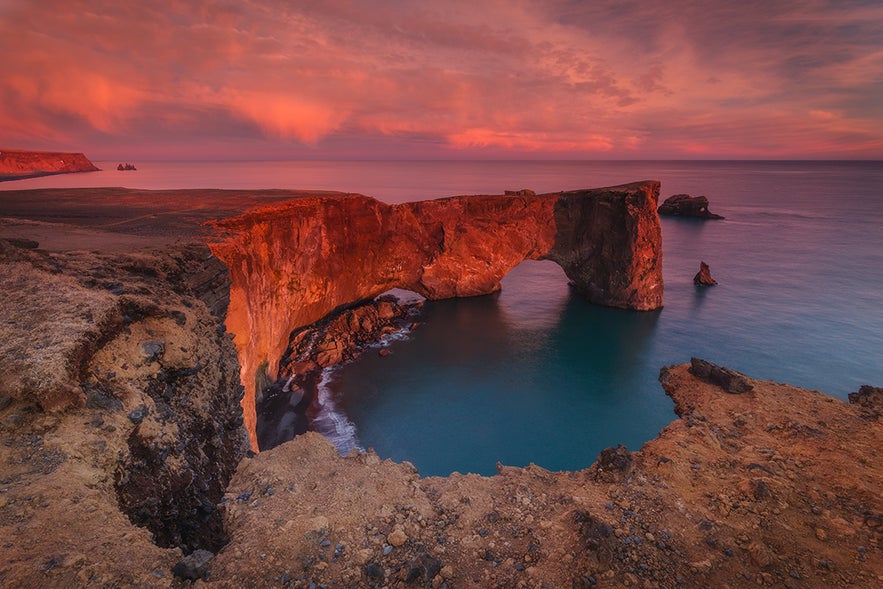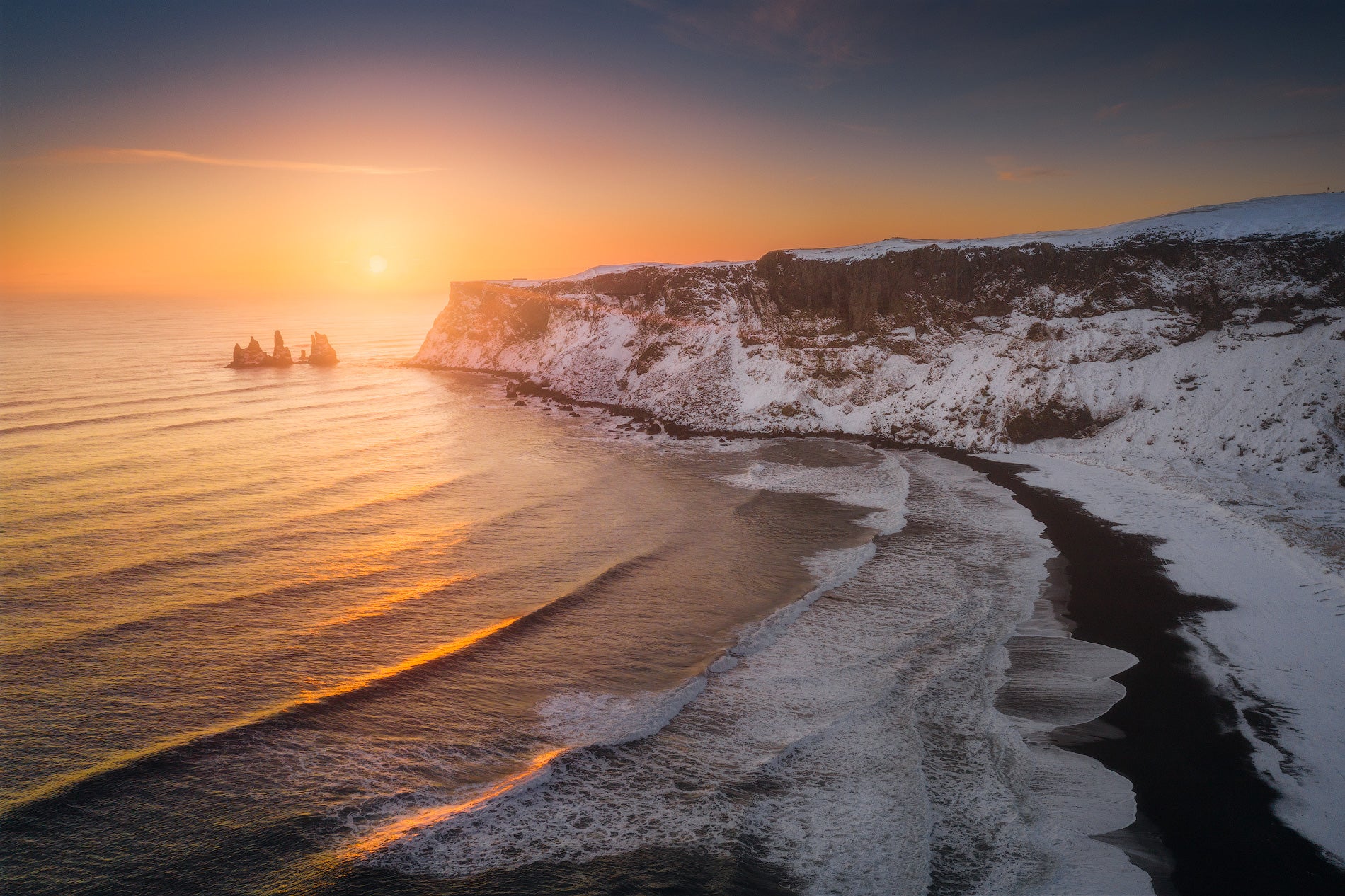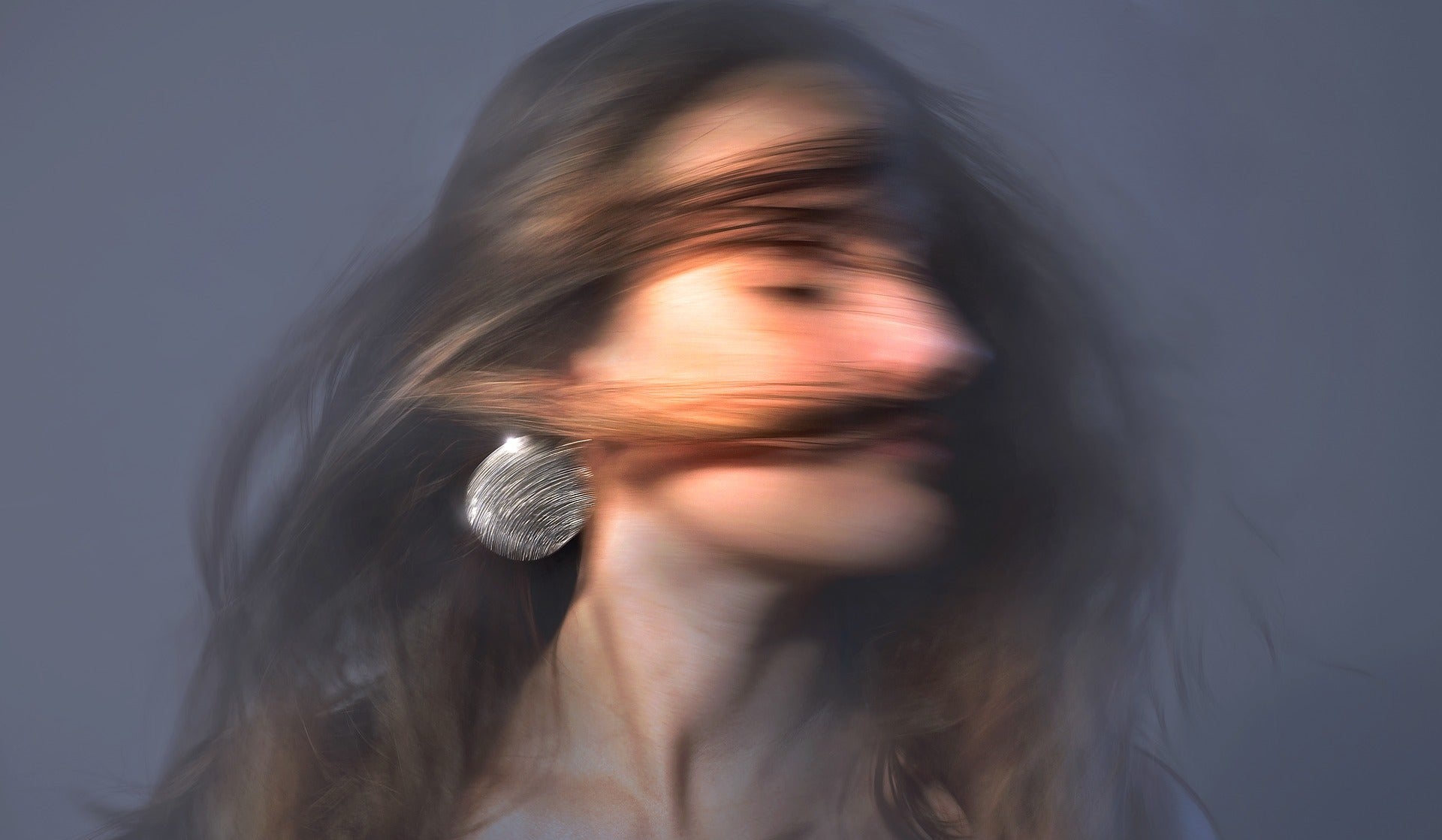
So you’ve been reading a lot about landscape photography tips and you’ve picked up a thing or two, but they just seem a little basic. Often, these tips are aimed at photographers who are just starting out. If you’re a little bit more advanced in your practice, then it’s time to start examining what it takes to make a truly stunning photograph.
- Learn about Landscape Photography Composition Techniques | The S Curve
- Discover 4 Popular Photography Techniques To Try In Iceland
- Here are 5 Composition Techniques That Will Improve Your Landscape Photography
While you’re in Iceland, you’ll have so many opportunities to put into practice all of the photography techniques that you’ve learned. It will also be the best time to delve a little further into harnessing your creativity.
While there always something that you can improve upon with regard to the technical aspect of photography, the five tips that we’re about to talk about will help you to focus your attention in the field and equip you with the greatest ability to produce truly amazing photos from Iceland.
Tip #1 - Make Time to Scout Locations
 Scouting in a location that you want to shoot can reveal interesting subjects. Photo by: 'Iceland Photo Tours'.
Scouting in a location that you want to shoot can reveal interesting subjects. Photo by: 'Iceland Photo Tours'.
While it may seem like you won’t have very much time during your trip to do much other than to arrive at a location and begin shooting, it can really pay off to schedule some time to explore your surroundings.
You may have done a lot of research already by looking at other people’s photos in order to ascertain where you want to shoot, but even so, once you arrive at a location, there are so many different things to take into account.
Of course, you can always scout once you have both feet on the ground in Iceland but some of it can still be done from the comfort of your own home, behind your computer screen.
 Desktop applications can help you to figure out angles and what a location has to offer. Photo by: 'Iurie Belegurschi'.
Desktop applications can help you to figure out angles and what a location has to offer. Photo by: 'Iurie Belegurschi'.
Desktop and mobile applications such as Google Earth will allow you to understand a scene long before you actually travel. These kinds of apps can give you a 3D view, by placing you into the landscape before you’re actually even there.
The advantage of this is that you’ll be able to get a bit of a feel for what the location has to offer in terms of perspectives and angles. You’ll also be able to plan out distances to figure out what kind of equipment will benefit you once you’re there.
Another way of scouting is to look for photos of the same location that were taken during different months and seasons. This will help you to plan the perfect time to visit Iceland, to fit in with what you’d like to photograph.
 Scouting online can help you to figure out the best times to travel. Photo by: 'Iurie Belegurschi'.
Scouting online can help you to figure out the best times to travel. Photo by: 'Iurie Belegurschi'.
For example, if you’d like to shoot fields of purple lupines at the fishing village of Vík, then it would be best to travel in the summer months, when the wildflowers are in bloom.
Similarly, if you’d like to photograph crystal blue ice caves, then you’ll have to visit Iceland in winter when the ice caves are accessible.
 Ice caves are only accessible for a small part of the year, so it's important to know when to travel. Photo by: 'Iurie Belegurschi'.
Ice caves are only accessible for a small part of the year, so it's important to know when to travel. Photo by: 'Iurie Belegurschi'.
By taking the time to research and scout your locations for landscape photography in Iceland, you’ll be able to work out the optimal time to visit to photograph seasonal elements.
You’ll also be able to work out the best time of day to shoot at these locations, such as during sunrise or sunset, by anticipating how the light will affect the scene during different times of the day.
Once you’re actually in Iceland and at your shooting locations, there is still some scouting to be done. You can quickly understand the scene by visually assessing the area, looking for interesting compositions and foregrounds that may be incorporated into your shots.
In order to make the most of on-location scouting, try arriving an hour or two before your allocated shooting time. This will give you enough leeway to search for the perfect composition and to set up your shot to coincide with the magical light.
 Scout for locations before you shoot at night. Photo by: 'Iurie Belegurschi'.
Scout for locations before you shoot at night. Photo by: 'Iurie Belegurschi'.
This is especially important for photographing the Northern Lights at night, as you won’t want to be stumbling around in the dark at an unknown spot that you’ve never visited before… not to mention that you won’t be able to see very much at night!
Tip #2 - Communicate the Mood
Oftentimes when people visit Iceland, they struggle with the weather and the conditions for photography. Let’s face it – it’s not very often that we have good weather here, so if you’re blessed with blue skies and sunshine, then try to make the most of it!
 It isn't always sunny in Iceland. Photo by: 'Iurie Belegurschi'.
It isn't always sunny in Iceland. Photo by: 'Iurie Belegurschi'.
More often than not, during your photography trip to Iceland, you’ll likely experience storms and grey, cloudy scenes. This doesn’t mean that you should stop shooting and it most definitely doesn’t mean that your chances at producing great landscape photography of Iceland are ruined.
The trick to photographing the landscape in Iceland is to make the most of the conditions by utilising them to convey different atmospheres and moods. Communicating the mood in a scene is the best way to express the beauty of the landscape.
- See also: How to Take Great Photos in Bad Weather
If you’re still shaking your head, then think of it a little like this: different conditions can impact upon what you can convey within each photograph.
 Waves crash in on a stormy day on the Snaefellsnes Peninsula. Photo by: 'Iurie Belegurschi'.
Waves crash in on a stormy day on the Snaefellsnes Peninsula. Photo by: 'Iurie Belegurschi'.
For example, stormy weather can be used to create dark and dramatic scenes, particularly along the Snæfellsnes Peninsula coastline, where fierce waves lash the cliffs in a display of nature’s true power.
 Cloudy days in the Highlands can portray a different kind of beauty. Photo by: 'Iurie Belegurschi'.
Cloudy days in the Highlands can portray a different kind of beauty. Photo by: 'Iurie Belegurschi'.
Cloudy days in the Highlands can portray a silent, vast beauty that would otherwise be impossible to capture if the sky were a bright shade of blue.
The most obvious way to communicate the mood of the landscape is to use the juxtaposition between light and shadow. Bright images can give the viewer a completely different feeling to what they would experience if they were to look at a darker scene.
 The Midnight Sun can create long shadows. Photo by: 'Iurie Belegurschi'.
The Midnight Sun can create long shadows. Photo by: 'Iurie Belegurschi'.
During the Midnight Sun season in Iceland, the position of the light can create long shadows amongst warmly lit landscapes, making for a passionate and inviting mood.
Think of that nostalgic feeling that you get on long summer days, when fiery sunsets blaze across the sky. This is exactly how you want to be able to communicate moods through your photographs, to invoke a sense of connection between your audience and the landscapes that you will capture during your landscape photography trip to Iceland.
- See also: Summer Workshops in Iceland
Tip #3 - Be Patient and Wait for the Decisive Moment
 Wait for the decisive moment to take your shot. Photo by: 'Iurie Belegurschi'.
Wait for the decisive moment to take your shot. Photo by: 'Iurie Belegurschi'.
It may be difficult to be patient, particularly when you have a list of places to get to and photograph during an action-packed stopover in Iceland, but waiting for the right moment can drastically improve upon the images that you take.
Sure, you can take a photo of a waterfall during anytime of the day, but to produce a really great photograph, there are certain times of the day that will be better than others.
Waiting for and anticipating the right moment to take a photograph are important virtues in landscape photography, particularly when you’re in a place as visually striking as Iceland.
You can’t control what’s going to happen in terms of the lighting and other conditions such as wind, rain or snow, but oftentimes, you can integrate these factors into your shot to help bring out a certain atmosphere, level of interest or feeling within your photos.
 Waiting for the decisive moment at the Jokulsarlon Glacier Lagoon can give your photos a different dimension. Photo by: 'Iurie Belegurschi'.
Waiting for the decisive moment at the Jokulsarlon Glacier Lagoon can give your photos a different dimension. Photo by: 'Iurie Belegurschi'.
Imagine for a moment that you’re shooting at the Jökulsárlón glacier lagoon. There are large icebergs floating within the placid waters but every now and then, a flock of seabirds flies by in perfect formation.
Recognising their pattern of movement, you can aim to take a shot as they enter your frame, helping to bring another element of interest into an otherwise straight-up composition of icebergs.
Developing the patience to wait for the right moment to shoot can mean that you’re able to add something special that brings out a whole new dimension to your composition. This applies particularly to light, as even shooting half an hour before sunset can turn out drastically different than if you were to shoot during sunset or even half an hour later.
Shooting at the wrong time of day may mean that you miss capturing that perfect moment, when the colours in the sky tie together with the scene to make for a truly enchanting shot.
Tip #4 - Get Outside Your Comfort Zone
 If you don't like shooting into the sun, then try shooting straight into it to create a sunstar! Photo by: 'Iurie Belegurschi'.
If you don't like shooting into the sun, then try shooting straight into it to create a sunstar! Photo by: 'Iurie Belegurschi'.
One of the best ways to improve upon your landscape photography is to experiment with different styles and ways of shooting. By getting outside of your comfort zone, you’ll be able to really figure out what gets you ticking, in order to find your own niche.
While you’re in Iceland, try photographing things that you don’t normally like to shoot. For example, if seascapes aren’t really your thing, try heading out along the coastline to give it a try.
You don’t have to be particularly good at it but by giving yourself a challenge, you might find that you learn something useful that will change the way that you shoot and enjoy landscapes in the future. This will help you to explore photography and to really grow as a landscape photographer.
Tip #5 - Pre-Visualise the Shot
 Pre-visualisation can help you to be at the right place at the right time for the shot. Photo by: 'Iurie Belegurschi'.
Pre-visualisation can help you to be at the right place at the right time for the shot. Photo by: 'Iurie Belegurschi'.
Last but not least, one of the keys to improving as a landscape photographer is to learn to pre-visualise.
If you already know the locations that you’ll be travelling to shoot in, then try picturing the kind of photo that you want to take at each scene. Think about how you want the lighting to be, what the colours will look like, how you’ll frame the shot and what you want to use as your foreground.
Pre-visualising your images like this will give you a good idea of what you’re looking for when you finally arrive at the location, to help you fulfil your dream of taking the perfect shot at each spot. It can also help to use desktop and mobile apps such as PhotoPills to plot out the best time to photograph the stars, sunrises or sunsets in certain places, so you can aim to be there at the perfect moment.
About the author: Serena Dzenis is a landscape photographer based in Iceland. You can find more of her work on her website or by following her on Facebook and Instagram.
Have you tried any of these tips that we’ve mentioned above? How useful were they for you in improving upon your landscape photography? Have you got any additional tips that others may find useful? Leave a comment below!












